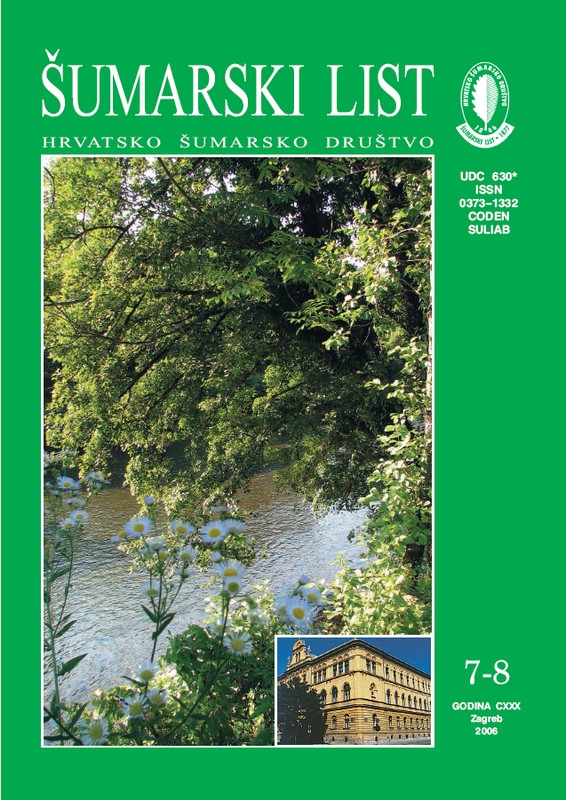
broj: 7-8/2006
pdf (20,9 MB) |
|
||||||||||||||
| IZVORNI ZNANSTVENI ČLANCI | ||
| Ballian, Dalibor | UDK 630* 165 (001) | |
| Controlling the Serbian Spruce Origin (Picea Omorika /Panč./ Purk.) at the Kakanj Plantation with Isoenzyme Markers pdf HR EN | 295 | |
| Kremer, Dario | UDK 630* 164 + 233 (001) | |
| Morphological Differences Between White Ash (Fraxinus americana L.) and Green Ash (F. pennsylvanica Marshall) Introduced in Croatia pdf HR EN | 305 | |
| Prka, Marinko | UDK 630* 321 + 325 (001) | |
| Features of Assigned Beech Trees According to the Type of Felling in the Felling Areas of Bjelovarska Bilogora and their Influence on the Assortment Structure pdf HR EN | 319 | |
| PREGLEDNI ČLANCI | ||
| Zelić, Juraj | UDK 630* 521 + 522 + 531 | |
| Do Trees in a Forest Grow by the Rules of the Golden Section and the Fibonacci Series? pdf HR EN | 331 | |
| Summary: The analysis of biometric parameters of growth (yield tables) of forest stands of beech EGT-II-D-11 (beech with sedge, Bezak et al, 1989) and pedunculate oak (Quercus robur L.), Bezak, 2004, provides a possible answer to the question: “Do trees in a forest grow by the rules of the Golden section and the Fibonacci series?” The Golden section or the Divine proportion was discovered in ancient cultures and civilizations. It has always been applied as the ideal proportion in art and construction. It is revealed in the live material world of natural patterns of plant and animal growth and development. Expressed with the number of the decade system, it is as follows: f = (Ö 5 +1) / 2 = 1,6180339 ... Closely related with the Golden section proportion is the Fibonacci series, a set of real numbers whose member in a series equals the sum of two previous ones, e.g. 1, 1, 2, 3, 5, 8, 13, 21, 34, 55, 144, … It was found that growth of forest trees in diameter follows the rules of the Golden section and Fibonacci series; this relates to the growth of breast diameter, basal area, tree circumference and crown width as a linear dependent variable of breast diameter. The growth of a tree’s breast diameter can be expressed with a linear function of the following shape: d = a + b t, in which breast diameter is a dependent variable and tree age an independent one. Regression coefficient b shows the rate of tree growth or increment, which is different for particular tree species and environmental conditions in which a tree grows. It is expressed as a b-module, which together with the regression constant a represents geometric growth of an equilateral spiral within the so-called square whirl in relation to the golden section sides. During its life, a tree in a stand “tends” towards the average increment (growth speed) expressed with the value of the b-module. Speed of growth or diameter increment, represented mathematically with a derivation of linear constant, provides the constant b as an expression of harmonious motion with a positive prefix. The b-module may be used to make a numerical expression of site classes for tree species or determine ecological-management forest types. The model presupposes that the force of tree growth in diameter is not inhibited by the force of resistance to growth as an internal structure of growth, whereas oscillations in growth (increment) are caused by external forces. Tree growth in height, represented by a mathematical function of the second degree, does not assume the patterns of the Golden section and the Fibonacci series because the force of growth is inhibited by a suppressed force, the force of resistance to growth. This force increases with ageing of trees and ends with the maximum of tree height, when the force of resistance to height growth equals the force of growth. The speed of height growth is individual for each tree species and is conditioned by external influences, site class, warmth, light, air circulation, stand density, etc. The volume of tree growth is the function of growth of breast diameter, height and form factor. It is caused by the internal structure of growth of two opposing forces and by external forces of growth and does not manifest growth according to the rules of the Golden section and the Fibonacci series. The Golden section of tree volume, as an ideal point of balancing the proportions of external tree habitus and underground part (root) should be sought with another methodology. Key words: equilateral spiral; forces of resistance to growth; growth equation; growth forces; growth of tree breast diameter and crown diameter; height and volume growth; square whirl.; suppressed and forced motions; the Fibonacci series; the Golden section | ||
| STRUČNI ČLANCI | ||
| Rosavec, Roman | UDK 630* 272 | |
| Park-Forest “Komrčar” on the Island of Rab – Condition and Valorization pdf HR EN | 345 | |
| Šegrt, Viktor, E. Menđušić, G. Horvatović, M. Grubešić, K. Krapinec | UDK 630* 151 | |
| Injuries of Predator Birds – Data for 2005 pdf HR EN | 353 | |


